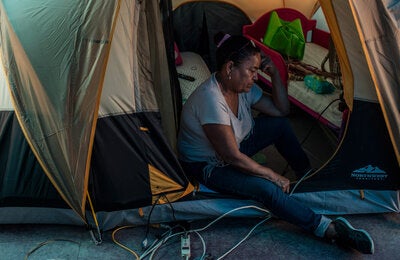

During the 1990s, the rate of exclusive breastfeeding nearly tripled, but in recent years, progress has slowed. PAHO/WHO, UNICEF and NGO partners are working with the government to step up support for breastfeeding.
During the 1990s, the rate of exclusive breastfeeding nearly tripled, but in recent years, progress has slowed. PAHO/WHO, UNICEF and NGO partners are working with the government to step up support for breastfeeding.
July 2013 (PAHO/WHO) - Yocelin Vargas Sanchez, is a 21-year-old mother of two: six-year-old Elard and a beautiful newborn baby girl. Yocelin gave birth at the Hospital Nacional Cayetano Heredia in Lima, Peru, where they showed her how to breastfeed her baby.
"After I had my baby, they gave her to me and I put her to my breast, so she could feel the warmth of her mum, and then I breastfed her. They taught me how to put her in a good position so she can take the nipple and areola into her mouth. It wasn't difficult. It was a very nice experience to see how she latched onto my breast for the very first time."

PAHO/Inés Calderón
Yocelin breastfed her first child Elard until he was two and a half, and she is determined to breastfeed her new daughter for just as long, because she understands the benefits. "Elard doesn't get sick, because I gave him only my breast milk. Now, with my second baby, I'll breastfeed until she is two or three years old."
PAHO/WHO recommendations
In line with what Yocelin practiced, the Pan American Health Organization/World Health Organization (PAHO/WHO) recommends:
- initiation of breastfeeding within one hour of birth
- exclusive breastfeeding for the first six months of life
- introduction of solid foods at six months together with continued breastfeeding up to two years of age or beyond.
Breastfeeding is the best source of nourishment
PAHO/WHO promotes breastfeeding as the best source of nourishment for infants and young children and one of the most effective ways to ensure child health and survival. Breast milk is safe and contains antibodies that help protect infants from common childhood illnesses. Breast milk is readily available and affordable. People who were breastfed as babies are less likely to be overweight or obese later in life. They may also be less prone to diabetes and perform better in intelligence tests.
If every child in the world were breastfed, some 220 000 lives could be saved each year. A recent analysis of studies in Ghana, India and Peru showed that infants who were not breastfed were 10 times more likely to die than those who were predominantly or exclusively breastfed.
Breastfeeding rates increased
Globally, about 38% of babies are exclusively breastfed for six months. In Peru, the rate of exclusive breastfeeding increased dramatically during the 1990s — from under 20% in 1992 to just over 57% in 2000 — thanks to a nationwide effort to train health workers and implement the WHO/UNICEF baby-friendly hospital initiative which certifies that facilities support breastfeeding. Peru's rate is therefore well above the global average, but in the last few years progress has slowed (2012: 67.5%). In some areas, mostly cities, there is evidence of a downward trend.
Just over half of all babies born in Peru (55%) now begin breastfeeding within an hour of birth. Rates are lower among those born in health facilities, those that are delivered by health professionals, those born in urban areas, and those whose mothers have higher income and education. This may seem surprising, as in high-income countries the situation tends to be reversed — mothers with higher income and more education are more likely to breastfeed.
Formula milk marketing a continuing threat
"Although Peru has been a leader in terms of regulations to promote breastfeeding, we are seeing increases in donations of infant formula to mothers and in marketing and "gifts" to health facility staff and health services from formula makers," said Fernando Leanes, PAHO/WHO's Representative in Peru. "These undermine the successes of the past few decades. PAHO/WHO, UNICEF and a wide group of NGOs are now working together with the government to step up support for breastfeeding once more."
Strategic Plan to strengthen existing regulations
A Multisectoral Strategic Plan for the Promotion and Protection of Breastfeeding 2013-2021 will strengthen enforcement of existing regulations on infant feeding, ensure that workplaces have breastfeeding rooms, and re-assess hospitals that have previously been certified as "mother- and baby-friendly" to confirm that they still support breastfeeding.
With these actions, Peru will work towards increasing the rate of exclusive breastfeeding up to six months and continued breastfeeding up to 24 months by 2% per year up to 2021.
Yocelin plans to spread the word in her community: "Breastfeeding is very good. Together with love, breast milk is the food that my baby needs."



